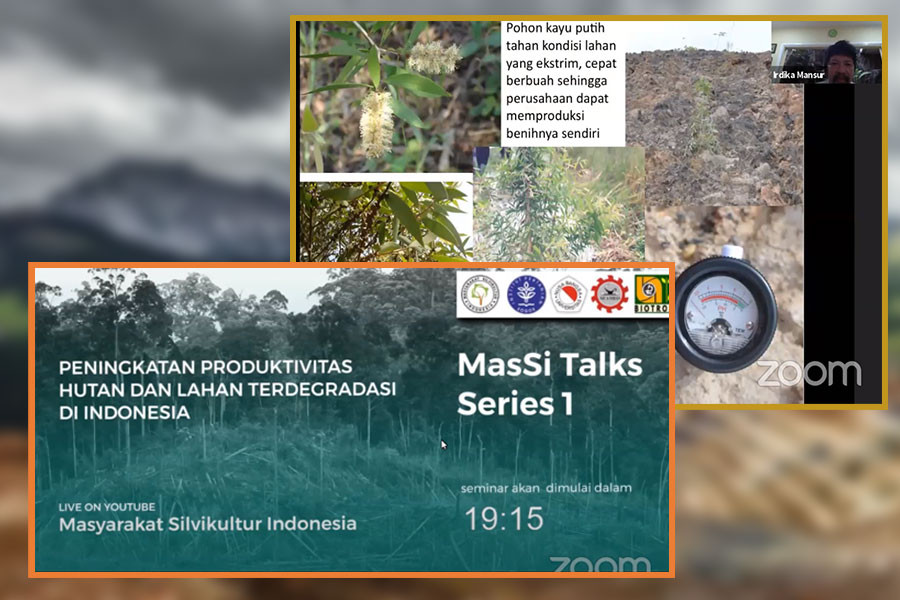Ir Irdika Mansur, MForSc, PhD, the Centre’s Director, was invited by the Indonesian Silvicultural Society (Masyarakat Silvikultur Indonesia / MASSI) to be a resource person for the MasSi Talks Series 1 ‘Increasing Productivity of Forests and Degraded Land in Indonesia’ which was held on 12 June 2020. Dr Irdika delivered his presentation on ‘the Utilization of Cajuput Trees (Melaleuca leucadendron) in Post-Mining Land.
In his talk, Dr Irdika mentioned that mining activities in production forest area should be integrated with conservation activity. Within the past 25 years, the development of post mining reclamation has been improved in Indonesia, starting from using plants just for making green the sites to the establishment of the regulation of the Minister of Forestry of Indonesia no.60 year 2009 concerning the superior local plant species used for reclamation. One of the plants is cajuput tree, which is native to eastern Indonesia. “Cajuput tree is suitable to be cultivated in ex-mining land since it is able to survive in marginal land and to form timber forest. The plant can regrow if damaged by livestock and fire disturbance. It is also not eaten by livestock and no community will steal the leaves,” said Dr Irdika.
Seedlings, he continued, can be obtained through seeds or shoot cutting technique. One kilogram of seeds contains more than one million seeds. The seed germination process is easy to do and the seedlings are ready for planting within 3-4 months after germination. Meanwhile, propagation through shoot cuttings does not require hormone treatment.
Before planting, the soil has to be treated first because post-mining land is infertile and dense (heavy soils) and has a low pH and low porosity. To solve this matter, Dr Irdika said that the addition of organic materials is the key. These materials act as pH buffer, nutrient provider and moisture keeper, improve soil structure, and invite micro and macro fauna and microorganisms. Organic materials can be applied both to all areas or only at the planting holes (for cajuput tree, 1-2 kg of materials per hole is required).
“Seedlings are then planted at a spacing of 4x4 meters in accordance with planting regulations on post-mining land. However, if the aim is for production as well, then spacing of 2x2 meter and 3x1 meter can be applied,” said Dr Irdika. “In its management, the trees are cut 1.1 meters above the ground so that light can enter the forest floor in full. For this reason, its potential for agroforestry and silvopastura is very high and permanent.”
Cajuput leaves are harvested 4 years after planting, then can be harvested every 9 months. He mentioned that harvesting the leaves and branches does not kill the trees so that land stability can be maintained. The leaves are distilled to produce cajuput oil, and the waste can be used as boiler fuel and compost and to passively neutralize acid mine drainage.
In his presentation, Dr Irdika also emphasized that cajuput trees provide fast economic and social advantages. Cajuput oil demand per year is currently estimated at 4000 tons, but production has only reached 500 tons; and not many people or the private sector are working on it. Thus, this can also be a promising market opportunity.
The webinar which was moderated by the Secretary-General of MASSI, Dr Ir Luluk Setyaningsih, MSi, also presented Prof Dr Ir Nurheni Wijayanto, MS, from the Department of Silviculture of IPB University, and Marinus Kristiadi Harun, MSi, from BP2PLHK Banjarbaru. They talked about ‘Agroforestry – Managed Succession Process to Increase Productivity of Forests and Degraded Land’; and ‘Techniques for Rehabilitation of Forests and Peatlands through Agroforestry System’, respectively.
The full record of this webinar can be accessed at https://www.youtube.com/watch?v=-yhk1qq6Yxo. (zsp)
 Wednesday, 02 September 2020 on 12:00pm
Wednesday, 02 September 2020 on 12:00pm
